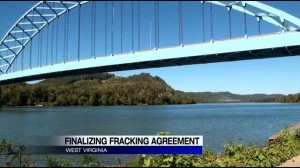Fracking Approved Under Ohio River in Marshall & Wetzel Counties, WV
From a Report by WTRF News 7 — Wheeling, March 25, 2015
For the first time ever, officials in West Virginia have come to an agreement to allow fracking under the Ohio River. It will happen on about 474 acres of land beneath the river in Marshall and Wetzel Counties.
The deal was reached between the state of West Virginia and Statoil. The company has agreed to pay an average price of $9,000 per acre. The state will receive 20 percent production royalties.
Leasing state-owned land for hydraulic fracturing is a new venture for the state. Many people said they are worried about the effects.
“To me, knowing what I know about fracking in general, you know it seems like it could affect the quality of the water,” said Patricia Thibeault of Moundsville.
Fish Creek resident Robin Hoyt agreed. “I think it’s a little dangerous myself. It could get into the water system, or different things if it would break and it scares me a little bit. All of the gas scares me a little bit because there is just so much of it and so many places now,” she said.
Department of Commerce spokeswoman Chelsea Ruby told the Associated Press that the state is still finalizing drilling agreements with Gastar Exploration and Noble Energy.
>>>>>>>>>>>>
Note: The State of WV should have learned lessons from the drilling & fracking in the Lewis Wetzel Wildlife Management Area where extensive damages were done to the public lands, the streams, the roads, etc. Recall the following information posted by SkyTruth:
The Marcellus Shale Natural Gas Boom in Wetzel County, West Virginia
Extracted from an Article by Jim Sheehan, SkyTruth Blog, October 7, 2012
Much of Wetzel County is forest, and as such exemplifies some of the best that “Wild and Wonderful” West Virginia has to offer. I believe this forest has particularly high value, ecologically and for other reasons, and may be vulnerable to this type of disturbance.
With the help of SkyTruth, here I explore the recent development of Marcellus (and other unconventional drilling) in Wetzel County. To show the increase in drilling I used well information and geographic coordinates for 102 completed unconventional wells in Wetzel Co. from 2007-2011 that I obtained from the West Virginia Geological & Economic Survey’s “Pipeline-Plus” database.
According to Pipeline-Plus, most of the 102 wells drilled target the Marcellus formation (75 as of 2011), but I also included wells that drill other Devonian Period formations. I did this after zooming in on all the well sites in Google Earth and finding they share a scale of activity (large pads for example) different from the conventional oil and gas drilling long a part of this region. It turns out the other Devonian Period formations can also hold high-value natural gas (wet gas or super-rich gas).
While the state owns the surface, most of the subsurface rights are privately owned. Because the area is public, it’s easy to directly observe the activity (within reason!), which I’ve done since 2008. Wyatt Run is one of the area’s forested headwater streams that in particular interests me, since it was one of the most pristine but now has been degraded by new activity. The integrity of headwater streams is crucial to downstream water quality. Wyatt Run flows to Fishing Creek, which in turn flows to the Ohio River.
The side of the ridge top well pad and a new one that occurred after the 2011 NAIP aerial, have “slipped” substantially due to the steep, rather unstable terrain, and are causing heavily sedimentation in Wyatt Run. There are efforts to correct the problem, but unfortunately it appears to be difficult to stop the erosion. As of September 2012 the sedimentation continues, and there have even been substantial direct impacts to the stream itself. Clearly, better planning is needed during the siting of well pads to avoid situations like this, and the amount of activity, at least in this watershed, appears to be at odds with industry claims of a light environmental footprint.
With new well pads comes much associated infrastructure that can fragment previously continuous forest, and potentially have a negative effect on wildlife that prefer large, undisturbed forest patches. While some wildlife may benefit, new roads and pipelines can also act as corridors – bringing in undesirable or exotic plants and animals. The drilling and site preparation also result in noise and air pollution. I can say first-hand that recreation (hunting, wildlife viewing, etc.) is much reduced in the formerly popular Lewis Wetzel Wildlife Management Area, and heavy vehicle traffic and the dust and potholes it brings seriously disturb the local community.
In closing, given the rapid increase in drilling, it is clear that the impacts to the forests of Wetzel County can happen very quickly. I wish to use what we can now see to increase awareness of environmental costs seldom heard about, and make them an important consideration in the development of this energy resource.
Jim Sheehan, GIS and remote-sensing specialist & PhD student at WVU, October 7, 2012
See also: www.FrackCheckWV.net


{ 2 comments… read them below or add one }
This note is a poor excuse for a real update, but the impact to the Lewis Wetzel WMA by gas well pads and pipelines continues.
The 2014 NAIP aerials are now available: http://wvgis.wvu.edu/data/dataset.php?ID=461.
Sadly, by the end of 2014, one of the truly majestic wild ridgetops remaining in the WMA, located just to the north of Slab Camp Road, was obliterated.
Why on earth is this even going on?
We have land fills venting natural gas into the air and burning it off. Sewage treatment plants are also just burning it off and using some for their own furnaces and so on. You would rather waste all of that and then possibly further contaminate our drinking water.
I have lost faith in any level of intelligence in this state.
REALLY Roger